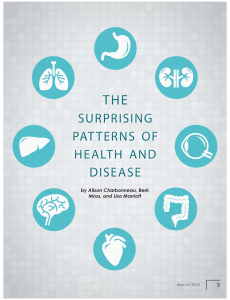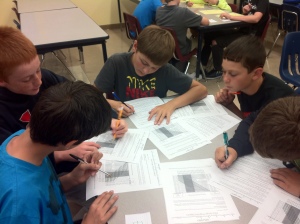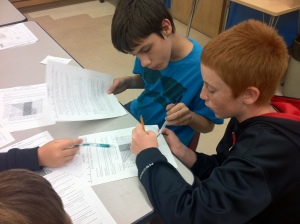Lesson Plan: The Surprising Patterns of Health and Disease
 This peer-reviewed lesson was published in Science Scope in March 2015. Science Scope is the peer-reviewed journal for middle school science teachers. Our lesson presents authentic data that helped scientists discover the field of developmental origins of health and disease (DOHAD). This lesson has been reviewed by scientists and teachers to introduce the concepts at a middle school level. Materials for this lesson are found at the bottom of this page.
This peer-reviewed lesson was published in Science Scope in March 2015. Science Scope is the peer-reviewed journal for middle school science teachers. Our lesson presents authentic data that helped scientists discover the field of developmental origins of health and disease (DOHAD). This lesson has been reviewed by scientists and teachers to introduce the concepts at a middle school level. Materials for this lesson are found at the bottom of this page.
Estimated Lesson Duration:
55 minutes (can be extended to a multi-day lesson if desired)
Overview:
In this jigsaw activity, students analyze five authentic data sets to explore some of the same patterns that helped scientists first understand how organ development in the womb can affect a baby’s health 50 years after birth.
Big Understanding: Students explore the crosscutting concept of patterns to understand how connecting patterns can lead to scientific discoveries. Using authentic data from World War II, students learn about a new area of medicine called “developmental origins of health and disease”, which studies how availability of resources can influence organ development and function. It also helps students to understand how organ development can help to predict organ function decades later.


Background:
- This lesson has no prerequisite for learning. It can be used in the beginning of the year to introduce the scientific process. It helps students practice reading charts and graphs. It also helps them distill the main point from the graph to share with their peers.
Key Concepts and Standards:
Key Concepts: resource availability, growth and function, chronic disease
NGSS Alignment:
Standard: MS-LS2 Ecosystems: Interactions, Energy, and Dynamics (pg 63)
Performance Expectation: MS-LS2-1. Analyze and interpret data to provide evidence for the effects of resource availability on organisms and populations of organisms in an ecosystem; MS-LS2-2. Construct an explanation that predicts patterns of interactions among organisms across multiple ecosystems; MS-LS2-4. Construct an argument supported by empirical evidence that changes to physical or biological components of an ecosystem affect populations (p63).
Science and Engineering Practices: Analyzing and Interpreting Data; Constructing Explanations and Designing Solutions; Engaging in Argument from Evidence; Scientific Knowledge is Based on Empirical Evidence (pg 63).
Disciplinary Core Idea: LS2.A: Interdependent Relationships in Ecosystems, LS2.C: Ecosystem Dynamics, Functioning, and Resilience (pg 63).
Cross Cutting Concepts: Patterns, Cause and Effect, Structure and Function, Scientific Knowledge Assumes an Order and Consistency in Natural Systems (p63).
Standard: MS-LS1 From Molecules to Organisms: Structures and Processes (pg 61)
Performance Expectation: MS-LS1-5. Construct a scientific explanation based on evidence for how environmental and genetic factors influence the growth of organisms. (pg 61)
Science and Engineering Practices: Constructing Explanations and Designing Solutions (pg 61), Engaging in Argument from Evidence (p61-62).
Disciplinary Core Idea: LS1.B: Growth and Development of Organisms (pg 61).
Cross Cutting Concepts: Cause and Effect, Structure and Function (p61).
ELA ALIGNMENT
Reading: Informational Text
· CCSS.ELA-LITERACY.RI.6.7 — Integrate information presented in different media or formats (e.g., visually, quantitatively) as well as in words to develop a coherent understanding of a topic or issue.
· CCSS.ELA-LITERACY.RI.7.3 — Analyze the interactions between individuals, events, and ideas in a text (e.g., how ideas influence individuals or events, or how individuals influence ideas or events).
· CCSS.ELA-LITERACY.RI.8.2 — Determine a central idea of a text and analyze its development over the course of the text, including its relationship to supporting ideas; provide an objective summary of the text.
Writing
· CCSS.ELA-LITERACY.W.6.1.A — Introduce claim(s) and organize the reasons and evidence clearly.
· CCSS.ELA-LITERACY.W.7.1– Write arguments to support claims with clear reasons and relevant evidence.
· CCSS.ELA-LITERACY.W.8.1 — Write arguments to support claims with clear reasons and relevant evidence
Speaking and Listening
· CCSS.ELA-LITERACY.SL.6-8.1 — Engage effectively in a range of collaborative discussions (one-on-one, in groups, and teacher-led) with diverse partners on grade 6-8 topics, texts, and issues, building on others’ ideas and expressing their own clearly.
· CCSS.ELA-LITERACY.SL.6.2 — Interpret information presented in diverse media and formats (e.g., visually, quantitatively, orally) and explain how it contributes to a topic, text, or issue under study.
· CCSS.ELA-LITERACY.SL.7.2 — Analyze the main ideas and supporting details presented in diverse media and formats (e.g., visually, quantitatively, orally) and explain how the ideas clarify a topic, text, or issue under study.
Literacy in History/Social Studies
· CCSS.ELA-LITERACY.RH.6-8.7 — Integrate visual information (e.g., in charts, graphs, photographs, videos, or maps) with other information in print and digital texts.
Science and Technical Subjects
· CCSS.ELA-LITERACY.WHST.6-8.9 — Draw evidence from informational texts to support analysis, reflection, and research.
Preparations/ Materials
1. Download and print overview and worksheet pages and 5 sets of task cards
- Example of “The Discovery of Blood Type through Patterns” and “Dutch Hunger Overview”
- Pattern Notes Summary Sheet to record observations
- Task Cards A-E
A. Dutch Hunger Pedigree Chart
B. Adult Heart Disease Histogram
C. Calorie Intake of Dutch Hunger Line Graph
D. Heart Development Timeline with Heart Research Cards
E. Dutch Hunger Pregnancy Diagram.
2. Divide students into 5 expert groups and let them know they’ll be the expert when they report back to their home group (different group of students).
3. As a class, discuss background example above and what they’ll be doing when they analyze their task cards (more details provided in lesson — trying to give you a sense of what students will be doing without breaking copyright permissions!)
4. Allow students to go through the guided task cards and discuss as a group what they uncover. They will be asked to record their key understanding in a box at the bottom of the worksheet. This is the key piece that they will need to share when they meet with their home group. Make sure everyone is in agreement with their answers.
5. Disperse each member of the expert group into one of five home groups (where there is at least 1-2 students per expert group who will report on what they’ve learned). Have students take turns presenting their findings and recording each others’ “Final Analysis”.
6. Debrief with students (prompting questions provided). Administer summative assessments, if desired.
Downloadable Lesson and Supporting Materials
Lesson Plans
- The lesson can be found on the NSTA website here: http://www.nsta.org/publications/browse_journals.aspx?action=issue&id=99298
- Citation: Charbonneau, A., Moss, G.B., and L.K. Marriott (2015). The suprising patterns of health and disease. Science Scope, 3, 3-9.
Please note that copyright permissions from Science Scope prevent us from publishing the lesson on our website, however, we are able to share the lesson and materials with you. To request full copy of the lesson and materials for personal or classroom use, please email us at LGH@ohsu.edu. We would also love to hear about if you’ve used the lesson in your classroom and if you’ve made any modifications to the lesson, which we’re happy to share here for use by others.
Worksheets
- All supplementary materials, summative assessments, etc. here:
http://www.nsta.org/middleschool/connections.aspx
Resources
- Password-protected site. Email us at LGH@ohsu.edu if you would like more information.
Grade Levels: High School, Middle School
Subjects: Health, Science, Social Studies



